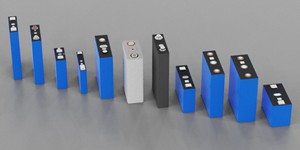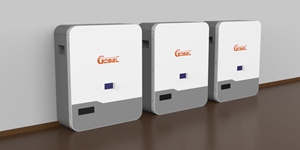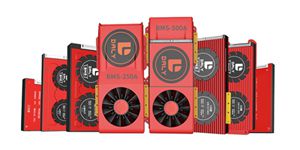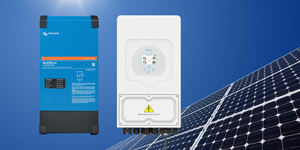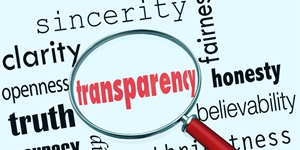SPECIAL REPORT ON HOUSEHOLD ENERGY STORAGE INDUSTRY: OVERSEAS HOUSEHOLD STORAGE IS BOOMING, OPENING A GOLDEN GROWTH PERIOD
By Kelly posted 2022-07-19 12:02:58The demand for energy storage is growing rapidly. In 2022, the world will usher in a new stage of household energy storage explosion, and the penetration rate has room to increase tenfold! Due to the maturity of energy storage technology and cost reduction, energy storage will begin to grow rapidly in 2021. In 2022, due to the rising energy costs and electricity prices in Europe, superimposed on the Russian-Ukrainian war and large-scale power outages overseas, residential electricity costs are high and power supply stability is poor. The high growth of household photovoltaics has brought about an unexpected outbreak of the household energy storage market.
Driven by European policies and economics, household savings have exploded, and U.S. household savings have grown rapidly. The installed capacity of household storage in Europe is showing explosive growth. Germany is the largest household storage market in the world. This year, the electricity price of German residents will reach more than 40 euro cents/kwh, which is three times higher than that at the beginning of 2021. The payback period of the optical storage system is 7-8 years. For example, considering the introduction of tax relief or direct subsidies by various countries, the payback period of investment will be further shortened to 2-3 years. (Report source: Future Think Tank)
Other countries in Europe, such as Italy, Poland, the United Kingdom, and the Czech Republic, are also accelerating their growth. We expect that the installed capacity of household energy storage in Europe will reach 10/23GWh in 2022/2023, an increase of 378%/133%. Chinese battery and inverter companies are in High recognition in Europe, fully benefiting from the outbreak of European household savings demand! Local dealer installers also benefit greatly. High electricity prices in the United States and poor power supply system, saving electricity costs based on self-use and peak-valley arbitrage, and the demand for household storage has grown rapidly. The U.S. household storage market focuses on local brands (Tesla/Enphase, etc.), and Chinese companies are gradually infiltrating industrial, commercial and ground energy storage. China's household storage economy is not high, but the local implementation of the mandatory allocation and storage policy, and the continuous increase in the peak-to-valley electricity price difference between industry and commerce, distributed energy storage is expected to gradually increase.
The new track for household energy storage, the world ushered in an acceleration period
Household energy storage: the core is the solar energy storage system with battery + energy storage inverter
Household energy storage is a necessary aid for distributed energy systems. According to the application scenarios, energy storage can be divided into user side (self-generated and self-consumption, peak-valley price difference arbitrage), power generation side (renewable energy grid connection, reduction of solar energy and wind), grid side (power peak regulation, frequency regulation), transmission and distribution side and Ancillary services (5G base station backup power), etc.
The core of the household solar storage system is photovoltaic + battery + energy storage inverter. Household energy storage and household photovoltaics are combined to form a household optical storage system. The optical storage system mainly includes cells, energy storage inverters (bidirectional converters), component systems and other parts. A typical system is generally 5KW ( components + inverter) supporting 10KWH (energy storage battery) or 10KW+10KWH, in which the battery is the core of the energy storage system, accounting for about 45-50% of the cost; the energy storage converter can control the charge and discharge, AC and DC The cost of solar power generation is about 10-15%; the component system, that is, the photovoltaic system used for solar power generation, accounts for about 20-25% of the cost; the installation cost will increase from 10,000 in 2021 to about 20,000, accounting for 15-20 %.
product series: household energy storage products are divided into integrated machine and split machine
Household energy storage system products include all-in-one and split. 1) All-in-one machine: The home-style photovoltaic energy storage and inverter integrated machine is an integrated integrated system with photovoltaic inverter, battery and controller placed inside. It can display the working status conveniently, quickly and intuitively through the touch screen, and can modify parameters and work in a variety of ways. mode, easy to use. Generally, there are three working modes: solar priority mode, AC (mains) priority mode, and SE priority mode (off-peak power consumption mode); 2) Split type (inverter + battery system): household split machine battery and inverter The inverters are installed separately, and the user can match the household energy storage inverter according to their own needs, and can also match the switching power supply or the inverter as a backup power supply. Generally, there are four types of hybrid home photovoltaic + energy storage systems, coupled home photovoltaic + energy storage systems, off-grid home photovoltaic + energy storage systems, and photovoltaic energy storage energy management systems.
Technical route: lithium iron phosphate battery is the mainstream route
The mainstream technology route of household energy storage is lithium iron phosphate, and sodium ion and lithium iron manganese are new paths in the future. The technical route of energy storage battery includes lithium ion, lead battery, flow battery, etc. At present, lithium iron phosphate battery is more in line with the design requirements of energy storage battery than ternary lithium battery due to its high safety and long cycle life. , is the mainstream development route of energy storage batteries, and Tesla energy storage batteries have gradually shifted from the ternary route to the iron-lithium route. In addition, some companies such as Ningde and Paineng are already conducting research and development and testing of sodium ion and lithium iron manganese batteries. We expect that the technical route of energy storage batteries is expected to be further improved in the future.
Industry barriers: product design and channel construction
The core barrier of household energy storage lies in the adaptation and channel advantages of energy storage inverters. Household energy storage, as a small energy storage battery, does not require high integrated core technology, and its core competitiveness is product design and market development (the key is market brand and channel construction). 1) Product design: mainly for adaptation to energy storage inverters (different countries/regions have different requirements) and customized product design for customer needs, for example, BMS and energy storage inverters in energy storage systems need Adaptation, the energy storage inverter controller communicates with the BMS through the CAN interface to obtain the status information of the battery pack, which can realize the protective charging and discharging of the battery and ensure the safe operation of the battery. 2) Channel construction: According to PV magazine's research, the biggest factor consumers consider when purchasing energy storage batteries is brand reputation. Consumers rarely know the source of the batteries and components used, and overseas channel certification cycles are complex and relatively In the long run, the channel construction and maintenance of energy storage manufacturers and downstream integrators and installers is particularly important.
Business model: multiple sales methods coexist, brand and channel building advantages
The sales model includes direct sales and distribution, brand and channel building advantages. The sales models of the three types of players in the household energy storage industry chain are as follows: 1) Battery cell/energy storage inverter suppliers: divided into To C and To B, To C generally integrates home storage systems, and automatically Building channels and promoting their own brands have certain consumption attributes. To B is a general product supplier who sells products to integrators, does not have consumption attributes, and earns material costs and processing fees.
Pricing model: Household storage has higher prices abroad, and the profit per watt-hour is lucrative
The price difference between domestic and foreign energy storage is the largest, higher than that of industrial and commercial energy storage and MW-level energy storage, and is nearly 133% higher than that of domestic energy storage (based on the highest price). At present, the domestic price of household storage products within 30kWH is 1.0-1.5 yuan/Wh, and the foreign price is 2.0-3.5 yuan/Wh, including the battery cell, BMS, shell, and connecting wire harness 10-year warranty. There are four kinds of quotations: EXW ex-factory price, FOB quotation, CIF quotation and DDP quotation. The quotation consists of goods pricing, accessories and FOB/CIF/DDP. At present, CIF offers are in the majority, and sellers take higher risks.
Demand volume: Demand is growing rapidly, and the world is ushering in an accelerated period of household energy storage
The demand for household energy storage is growing rapidly, with a year-on-year increase of 56% in 2021. According to BNEF data, the global installed capacity of energy storage in 2021 is about 10GW/22GWh, an increase of 84%/105% year-on-year, of which the installed capacity of distributed energy storage is about 2.5GW/5.6GWh, a year-on-year increase of 45%/40%. The installed capacity of household storage is about 1.9GW/4.4GWh, an increase of about 53%/56% year-on-year. The global household storage is booming. The main driving factors come from two aspects, one is the continuous increase of policy support, and the other is the high-yield economy. sex drive. (Report source: Future Think Tank)
Driven by high cost performance, the demand for household savings is booming
Reason 1: The cost of electricity is high and continues to rise
Under the energy crisis, overseas electricity costs continue to rise. In recent years, electricity prices in Europe and the United States have been rising year by year, and affected by events such as the Russian-Ukrainian conflict, the cost of natural gas has soared, and the cost of electricity prices has risen rapidly in the short term. Above MWh, electricity prices in European countries in May 2022 will increase by 100-330% compared with the beginning of 2021. According to ING's forecast, basic energy prices in European economies such as France, Germany, Belgium and the Netherlands will remain high at around 150-170 euros/MWh throughout 2022.
Reason 2: Weak power grid coordination and insufficient power supply reliability
Affected by extreme weather overseas, the coordination ability of power grid is weak, and the stability of power supply for residents is poor. In recent years, various large-scale power outages have occurred overseas. In 2021, the U.S. power grid system is relatively old, and Texas is affected by the cold current. According to EIA statistics, the average power outage time per customer in the United States in 2020 is as high as 492 hours, of which the outage time caused by major events such as severe weather and emergencies is 373 hours. In 2022, a power plant accident occurred in Taiwan, China, affecting 5.49 million households and losing 10.5 million kilowatts, accounting for about 1/3 of Taiwan's electricity. Household storage can provide emergency power in the event of power plant accidents or extreme natural disasters, improving the stability of electricity consumption.
Reason 3: Policy support such as tax reduction and exemption is gradually implemented
Overseas countries have introduced policies such as tax relief or direct subsidies to promote development. Relevant policies can be mainly divided into two categories. One is to implement relevant tax relief. For example, Italy will increase the tax relief for home storage equipment to 110%, and the United States will give up to 30% of investment in energy storage systems higher than 5kWh by 2026. Tax relief; the other is to implement financial subsidies, such as Japan providing 66% of the cost subsidy for households and businesses that install lithium-ion batteries, and Bavaria, Germany, providing 500 euros (550 US dollars) for each energy storage system with a capacity of more than 3kWh )subsidy.
Reason 4: High yield, short payback period
The rate of return of household savings is relatively high, and the rate of return can reach more than 15% without considering the subsidy, and the payback period is within 6-9 years. Germany, the United States and other countries in the forefront of the development of household energy storage in the world, due to their high electricity price yields, 1) Take Germany as an example, assuming a scale of 5KW, 50%*2h of distribution and storage, and the cost of household photovoltaic + energy storage is 2.06 EUR/W, the IRR is 22.55% after the calculation of the retail electricity price of 0.4 EUR/KWh and the feed-in electricity price of 0.06 EUR/KWh. 2) Taking California as an example, assuming a scale of 5KW, allocation and storage of 30%*4h, the cost of household photovoltaic + energy storage is US$4.63/W, calculated based on the peak electricity price of US$0.6/KWh and the average electricity price of US$0.23/KWh The IRR reaches 18.9%. With the decrease of system cost and the rise of electricity price, the IRR will be further improved. The high yield and short payback period overseas stimulate the rapid development of household storage.
Reason 5: The on-grid electricity price is lower than the electricity price
The grid-connected household photovoltaic electricity price policy has gradually shifted to self-consumption, promoting residents to allocate energy storage on the basis of photovoltaics. The current grid-connected household photovoltaic electricity price mainly includes three types of policies: the feed-in tariff policy (FiT), net metering and self-consumption. In Germany, Japan, Australia and other countries, the FiT subsidy price has been declining in recent years. The on-grid tariff of FiT surplus electricity in Germany has dropped by more than 80% in the past 15 years. Japan's household photovoltaic FiT has expired in sequence from November 2019, and the subsidy price after the expiration has been greatly increased. reduce. At present, some states in the United States have terminated the net metering plan, and countries such as the Netherlands and Italy will also withdraw from the net metering policy. Under the German self-consumption model, the on-grid electricity price is only 0.06 euros/kwh, and the self-use part is equivalent to making profits at the electricity price of 0.4 euros/kwh. Therefore, self-use after allocation and storage can improve the yield, while the FiT and net metering policies are gradually declining. , Since the consumption policy has been gradually promoted, the economy of residents' layout of light + storage has continued to improve.
Conclusion: The economical improvement of solar energy storage
The gap between the cost of solar energy storage LCOE and household electricity consumption is widening, and the economy of household solar energy storage is prominent. According to SPE, the average cost of electricity (LCOE) of photovoltaic + energy storage equipment in Germany in 2021 is 14.7 euro cents/kWh, which is close to 1/2 of the household electricity price in the same period, and the LCOE difference is 17.2 euro cents/kWh. We expect that the price difference between the two will continue to widen gradually in the future. By 2023, the solar + storage LCOE is expected to drop to 12.8 euro cents/kWh, and the gap between the LCOE and the household electricity price will increase to 18.9 euro cents/kWh in the same period. further highlighted.
Household savings in Europe exploded, and U.S. growth accelerated
Europe: The rapid growth of household savings, Germany leads Europe
The installed capacity of European household storage is in a trend of continuous growth. In 2021, European household storage will reach 2045MWh, a year-on-year increase of 73%. The compound annual growth rate from 15 to 21 will reach 63%, and the growth is very fast. Among them, Germany is the largest growth in European household storage. Power, in 2021, the installed capacity of German household storage capacity will reach 1,479MWh, accounting for 72% of European household storage capacity, followed by Italy (191MWh), the United Kingdom (81MWh), Spain (48MWh), and France (35MWh), with CR5 accounting for 90% in total .
Germany: The world's largest household storage market, the installed capacity of household storage continues to increase rapidly
Germany is the world's largest market for household energy storage, and the penetration rate of solar storage installations ranks first in the world. In 2021, Germany will add 1.48GWh of household energy storage, an increase of 45%, accounting for 34% of the world; the cumulative installed capacity is 3.92GWh, an increase of 60.6%, accounting for 32% of the world. In 2021, Germany's optical storage penetration rate will be 3.6%, ranking first in the world. Under the energy crisis, electricity prices have risen, stimulating a high demand for household storage. The average wholesale electricity price in Germany has risen from €52.8/MWh in January 2021 to a maximum of €206/MWh in June 2022, an increase of 313%.
Italy, Britain and Austria: household savings grow steadily
Soaring electricity prices and policy subsidies drive the development of household storage. With the exception of Germany, Italy, the United Kingdom, and Austria, which are at the forefront of the installed capacity of household storage, have steadily increased their installed capacity of household storage every year, driven by electricity prices and policies. By the end of 2021, the installed capacity of household storage in the UK is 81MWh, a year-on-year increase of 113%. Italy's installed capacity of household storage in Europe is second only to Germany. In 2021, the installed capacity of household storage in Italy will be 191MWh, an increase of 122%.
The United States: The energy storage market has a huge space, and the development of household energy storage is accelerating
The development of energy storage in the United States is on the fast track. The cost of energy storage systems in the United States has continued to decline, policy support has continued to increase, coupled with regulatory reforms by the federal and state governments, energy storage in the United States has developed rapidly. In 2021, the new installed capacity of energy storage in the United States will be 3971MW/10880MWh, and the installed capacity will increase by 341% year-on-year. Among them, household energy storage added 343MW/960MWh, accounting for 8.8% of the total newly installed energy storage capacity. The American Energy Storage Association believes that by 2025, the installed capacity of energy storage systems deployed in the U.S. energy storage market will increase fivefold. Among them, customer-side energy storage systems continue to constitute a major part of this growth.
China: At present, the economy of household storage is not high, and household storage manufacturers mainly target overseas customers
China's energy storage installed capacity is growing rapidly, and the main installed capacity is from centralized. China's energy storage installed capacity has been growing rapidly in the past two years. In 2020, the newly installed energy storage capacity will reach 1.37GW/2.48GWh, a year-on-year increase of 153%/189%. In 2021, the newly added energy storage capacity will reach 2.45GW/4.61GWh, a year-on-year increase of 79%. %/86%, of which the most important contribution comes from my country's centralized energy storage installations. my country's distributed energy storage is still in the early stage of development and the economy is not high. In 2021, the distributed energy storage installed capacity is 188MW/333MWh, a year-on-year increase of +11 %/-30%, and centralized energy storage accounts for over 90%.
Australia: Policy support, lighting and installation conditions drive the development of household storage
Policy support, better lighting and installation conditions drive the development of household energy storage. In terms of policy support, Australia has introduced a small-scale renewable energy plan and FiT subsidy policy to promote the installation of solar energy storage; in terms of light and installation conditions, Australia has sufficient light resources, high photovoltaic power generation efficiency, vast land and sparsely populated areas, and most residential buildings are villas. , suitable for installing photovoltaics, and the home storage system is highly economical. In 2021, Australia will achieve a household storage capacity of 206MW/494MWh, a year-on-year increase of 45% in terms of MWh.
Japan: Subsidy decline, unstable power supply, and suitable housing type drive the development of household storage
The penetration rate of household energy storage in Japan is relatively high, second only to Germany. In 2021, Japan's installed capacity of energy storage behind the table will be 931MWh (+8% year-on-year), and household energy storage will account for 90% of the energy storage behind the table. According to Infolink survey statistics, the number of houses suitable for PV installation in Japan exceeds 25 million. As of 2020, the installed PV and energy storage ratio will be about 10%/2%. Even in Japan, where the development of household PV is relatively mature, the future There is still a lot of room for expansion. In 2021, the proportion of photovoltaics equipped with energy storage will be 20.7%, and we expect the penetration rate to reach 38.5% in 2025. (Report source: Future Think Tank)
Analysis of key enterprises
Battery pattern: Tesla mainly supplies the United States, and Paineng Technology is deeply involved in Europe
Chinese manufacturers of energy storage batteries lead the world in shipments, and CATL ranks first in the world in shipments. According to our calculations, the global energy storage cell shipments in 2021 will be 59.9GWh, of which CATL ranks first as the largest cell supplier, with a shipment volume of 16.7GWh, accounting for 27.9%; Paineng Technology, as a household storage leader, Shipped 1.5GWh, accounting for 2.6%. We expect global shipments to be 114.9GWh in 2022, an increase of 91.9%, of which CATL will ship 45.0GWh, an increase of 169.5%; Paineng Technology will ship 3.5GWh, an increase of 127.3%.
Ningde Times: Energy storage battery shipments continue to increase rapidly, and the global leading position is stable
CATL provides full-scenario solutions for energy storage on the power generation side, power transmission and distribution side, and user side. The company's energy storage battery adopts the iron-lithium route, and provides 20-280Ah multi-specification cells to match the needs of different scenarios. It generally has three advantages of full-cycle high yield, all-round safety guarantee, and full-process solutions.
Paineng Technology: Top 2 household energy storage in the world, enjoying first-mover advantages in technology and channels
Paineng Technology provides comprehensive solutions for lithium battery energy storage systems. The company's energy storage products adopt the soft-packed iron-lithium route. It is one of the few energy storage manufacturers in China that can realize independent research and development and supply of battery cells + Pack. Energy storage applications in various scenarios such as new energy power generation, grid auxiliary services, microgrids, industrial and commercial parks, charging piles, data centers, and communication base stations.
300 million latitude lithium energy: differentiated competition of laminated iron and lithium, manganese iron lithium is expected to land in 22 years of production capacity
The order from Huawei exceeds 100GWh, and the investment in Wotai helps the rapid development of household storage. The company's energy storage products use the iron-lithium route, and provide a variety of energy storage products such as batteries, PACKs, systems, etc., covering fields including electricity, communication and household energy storage, which can provide a capacity of 50-304mAh, cycle 3000-7000 times, and discharge rate. 10 square iron-lithium products of 1C and 3C. In 2016, we took a stake in Wotai Energy, a large domestic energy storage system supplier, and mainly provided them with energy storage core products. We have received orders of over 100GWh of energy storage from Huawei, which we expect to deliver within 5-8 years.
Penghui Energy: Multi-point development in subdivision direction, rapid expansion of production due to numerous orders
Multi-point development in the subdivision direction, leading overseas certification of household energy storage, and excellent cycle performance of large-scale energy storage. The company's energy storage products adopt the iron-lithium route. In terms of household storage, it supplies battery products to downstream integrators. The product cycle life and safety performance are excellent. The certification progress of the overseas home storage market is industry-leading. We expect the company to pass the certification in North America and Japan in 2023. , expand the sales market; in terms of large-scale energy storage, the 4500-cycle cycle capacity of the product is ≥80%, and the 7000-cycle cycle capacity is ≥70%.
Xinwangda: The energy storage business is multi-line, and the battery cell is expected to achieve independent supply
The company provides a variety of comprehensive energy service models including lithium battery energy storage products, multi-scenario integration solutions, and energy investment and operation. The company's energy storage products adopt the iron-lithium route and are shipped in the form of modules and systems. At present, the batteries still need to be outsourced. The application fields of the products cover grid energy storage, industrial and commercial energy storage, network energy, household and portable energy storage, smart energy, etc. Scenes.
Narada Power: Accelerate new product iteration and global certification, and promote the implementation of global lithium battery projects
The company provides full-application energy storage product solutions, with complete certification work and a solid foundation for access. The company's energy storage products adopt the iron-lithium route to achieve full application and full coverage from industry to civil use, from power grid to household use, and from fixed to mobile. In 2021, a variety of new products will be released, such as the high specific energy fully pre-installed modular lithium battery energy storage system solution, the modular compact outdoor cabinet solution, and the smart IoT home energy storage system solution. The company's three-generation energy storage lithium battery products have passed the dual certification of South Korea's KC and KBIA for the first time; energy storage 5C lithium battery products and third-generation energy storage lithium battery products have passed UL9540A and IEC61508 certifications respectively.
Inverter pattern: Intense competition in the household inverter market and high shipment growth under strong demand
The pattern of household storage inverters is relatively concentrated, and the competition among manufacturers is fierce, and CR5 accounts for about 58%. In 2021, the global user-side energy storage inverter market will be more competitive, but the competition among manufacturers is fierce. Growatt ranks first, with a market share of about 13.8%. It is followed by 12.4%, 10.9%, 10.3% and 9.8% respectively. The difference in the market share of the top five is small, with CR5 accounting for about 58%.
Jinlang Technology: High growth in energy storage shipments has become the second growth pole
The power range of the energy storage inverter is 3-10KW. The company's energy storage inverters are mainly aimed at households and industrial and commercial use. At present, there are mainly three types of products. The power coverage of the products is 3-10KW, which can realize on-grid and off-grid switching within 20ms. String shipments have grown rapidly, and energy storage has exploded. Distributed demand is growing rapidly, energy prices have soared, household storage demand has exploded, and the company's string and energy storage shipments have grown rapidly. We expect Jinlang string to ship 1.1 million units in 2022, an increase of 60%+. We expect 2023 Annual string shipments reached 1.3 million units, an increase of 18%; in terms of energy storage, we expect to ship 240,000+ units in 2022H2 and 300,000 units in 2022, an increase of 9-10 times, and energy storage will continue to increase 2-3 times growth, we expect to ship 1.2 million units in 2023, and the proportion of energy storage business revenue will continue to increase. We expect energy storage revenue to account for 54% in 2023, becoming the company's second growth pole The two major businesses performed brilliantly!
GoodWe: Deeply cultivating the European market, the growth of energy storage is dazzling
Committed to providing distributed energy storage solutions. The company's energy storage products are mainly aimed at household and industrial and commercial use. The household power coverage range is 3-10KW, and the industrial and commercial power coverage range is 5-100KW. The household energy storage solution includes a complete set of "energy storage inverter + battery" solutions. energy storage inverter and battery products. The industrial and commercial energy storage solution adopts a modular system configuration to flexibly match various industrial and commercial scenarios. The company raised funds in June 2022 for capacity expansion, and will expand the company's grid-connected/energy storage inverter and energy storage battery capacity by 40GW and 4.5GWh, and the energy storage and system business will accelerate.
Deye shares: focus on energy storage high-quality track
Continuously increase investment in research and development to develop overseas markets. In 2021, the company will launch 8KW/10KW/12KW three-phase low-voltage household energy storage inverters and 15KW low-fracture phase energy storage inverters. Strong competitiveness, while accelerating overseas product certification to develop overseas markets.
Sungrow: The energy storage field is firmly in the leading position, and the shipment volume continues to increase rapidly
A full range of energy storage products are covered. Sungrow has launched the industry's first full series of liquid-cooled energy storage solutions PowerTitan and PowerStack for large-scale ground, industrial and commercial power station application scenarios. 10kW home energy storage system and 50kW-1MW distributed energy storage system, energy storage products cover household, industrial and commercial and large-scale ground power stations.
Hemai shares: Micro-inverse shipments increase rapidly, energy storage accelerates
Micro-inverse shipments have increased rapidly, European shipments have exceeded market expectations, and the US market has accelerated its volume: under the IGBT shortage, micro-inverses have less impact due to the use of MOS tubes, and micro-inverses benefit from strong distributed demand. The company's 2022Q1 micro-inverse exceeded 15 10,000 units, we expect Q2 to increase by 30%-50% month-on-month, the US market is in a period of accelerated volume, and the US market is expected to ship 300,000 units in 2022. Due to energy shortages in Europe, prices continue to rise, and the demand for household photovoltaics and household storage is hot. , Europe's shipments are expected to account for 40%. We expect the company to ship more than 1 million units in 2022, an increase of 125%+, and continue to double in 2023.
Yuneng Technology: Micro-inversion explodes and grows rapidly, and energy storage begins to grow in volume
Emphasis on R&D + marketing + asset-light model, adapting to the high market demand. The company raised funds to build a research and development center to enhance the company's research and development strength and consolidate its technological advantages. In addition, the company adopts the asset-light model of outsourcing, which has great flexibility in production capacity and can quickly adapt to the high demand of the market. Under this model, the company will increase revenue and profit, and the scale effect will be more obvious.
Energy storage pattern: The Ningde era is the best, and players from all walks of life will expand production soon
Chinese manufacturers of energy storage batteries lead the world in shipments, and CATL ranks first in the world in shipments. According to our calculations, we estimate that the global energy storage cell shipments will be 117.2/182.1GWh in 2022-2023, an increase of 93%/55%; among them, CATL is the largest battery cell supplier, and we expect CATL to 2022- In 2023, the shipment will be 45.0/67.5GWh, an increase of 169%/50%, accounting for 38.4%/37.1%.
Jinpan Technology: Two-wheel drive of domestic large-scale storage + overseas household storage, and the leader of dry transformation will set sail again.
Power generation side energy storage: The medium and high voltage cascade technology is leading in the industry, and the production capacity and orders are coming one after another. 1) Technically, the medium and high voltage cascade scheme is an important idea to solve the economic efficiency problem of large-capacity energy storage. The company is one of the very few domestic companies with medium and high voltage cascaded energy storage technology. The series of products have entered the commercialization process, and the liquid cooling technology has been adopted for the first time in the world, which is advanced. 2) In terms of production capacity, it is planned that the Guilin/Wuhan digital energy storage plants have a production capacity of 1.2/2.74GWh respectively, with a total output value of over 4 billion yuan under full production, of which the Guilin plant was completed and put into operation in July. 3) In terms of orders, the company has now undertaken orders of 135 million yuan for medium and high voltage direct-mounted (cascade) energy storage system products, which fully reflects the company's strong product capabilities.
Kehua Data: Focus on the domestic power generation side, another idea of UPS leading cross-border energy storage
The shipments of energy storage inverters and energy storage systems lead the country in the country. The company has expanded from energy storage inverters to complete system products. By the end of 2021, the global cumulative installed capacity of Kehua's energy storage system integration has reached 2.6GW/3.8GWh. In 2021, the company will be ranked TOP2 by global shipments of Chinese energy storage inverter providers, TOP3 by domestic system integrators, and TOP5 by domestic energy storage system shipments, with a significant market position.
Costa: Methodology + Channel Power, Overseas Household Reserves are on the rise
Long-term: channel power superimposes brand power, and domestic and foreign energy storage markets develop in parallel. The company's main business is data center UPS. After years of deep cultivation, it has accumulated a large number of customers and channel resources at home and abroad. The existing resources can be reused in the energy storage track. At present, the company's overseas household storage and UPS customers highly overlap (more than 300) . In addition, affected by the nature of the company's UPS customers, the company will still have strong competitiveness in the domestic and foreign industrial and commercial energy storage markets in the long run. At present, the company's industrial and commercial energy storage products have been released, and it is expected to become the second pole of energy storage business growth in the future.
Kelu Electronics: Resonance at home and abroad, orders from the grid side exploded
The product strength is strong, and the integration of energy storage system is leading in China. The company has independently developed core technologies in the field of energy storage including battery PACK, BMS, energy storage inverter, and EMS. At present, the company's energy storage inverter products have covered a full range (500W-4MW), all types (high frequency modulation Modularization, traditional power serialization, high-voltage cascade), and at the same time cooperate with self-developed BMS, EMS, etc., it has strong system integration capabilities. In 2020, the company ranked 9th among Chinese energy storage system integrators in the domestic market, and 8th in overseas markets. In 2021, the company ranked 8th in overseas market shipments of Chinese energy storage system integrators.
Baoguang Co., Ltd.: cutting into operation from equipment, better profit model and infinite potential
EMS is strong and further expands the energy storage business. The company has accumulated many years of experience in EMS, leading many technologies in the industry. On this basis, the company further expands its energy storage business. The company's energy storage business currently has three modes: 1) EPC mode based on EMS equipment; 2) EMC mode; 3 ) software provider and service operation and maintenance. At present, the company's energy storage business includes two types of energy storage combined with frequency regulation and new energy storage.
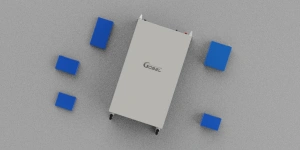
 Europe Warehouse
Europe Warehouse